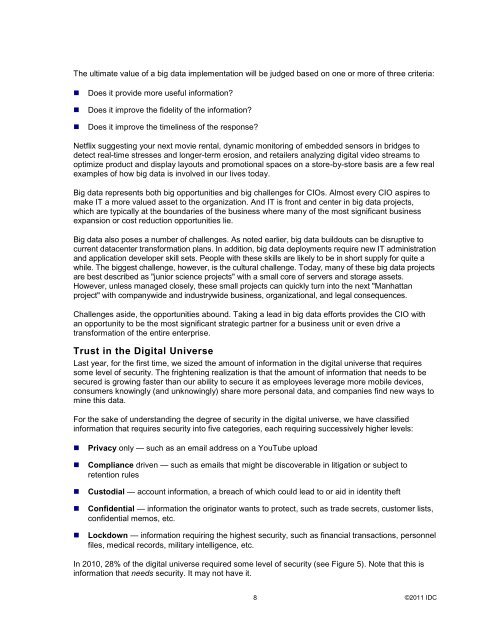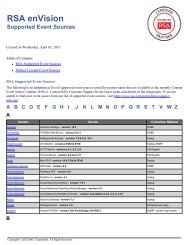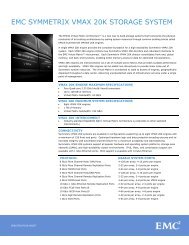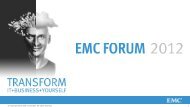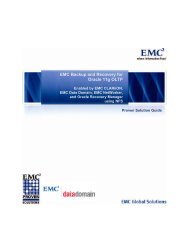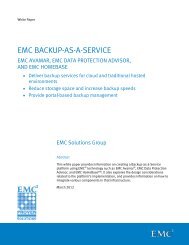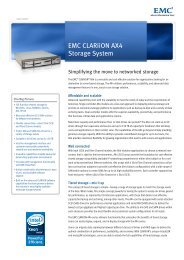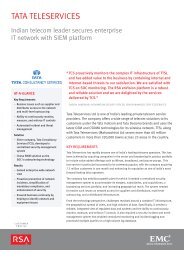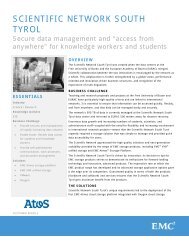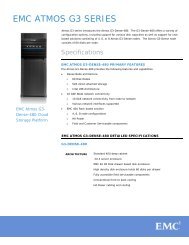Extracting Value from Chaos - EMC
Extracting Value from Chaos - EMC
Extracting Value from Chaos - EMC
Create successful ePaper yourself
Turn your PDF publications into a flip-book with our unique Google optimized e-Paper software.
The ultimate value of a big data implementation will be judged based on one or more of three criteria:<br />
� Does it provide more useful information?<br />
� Does it improve the fidelity of the information?<br />
� Does it improve the timeliness of the response?<br />
Netflix suggesting your next movie rental, dynamic monitoring of embedded sensors in bridges to<br />
detect real-time stresses and longer-term erosion, and retailers analyzing digital video streams to<br />
optimize product and display layouts and promotional spaces on a store-by-store basis are a few real<br />
examples of how big data is involved in our lives today.<br />
Big data represents both big opportunities and big challenges for CIOs. Almost every CIO aspires to<br />
make IT a more valued asset to the organization. And IT is front and center in big data projects,<br />
which are typically at the boundaries of the business where many of the most significant business<br />
expansion or cost reduction opportunities lie.<br />
Big data also poses a number of challenges. As noted earlier, big data buildouts can be disruptive to<br />
current datacenter transformation plans. In addition, big data deployments require new IT administration<br />
and application developer skill sets. People with these skills are likely to be in short supply for quite a<br />
while. The biggest challenge, however, is the cultural challenge. Today, many of these big data projects<br />
are best described as "junior science projects" with a small core of servers and storage assets.<br />
However, unless managed closely, these small projects can quickly turn into the next "Manhattan<br />
project" with companywide and industrywide business, organizational, and legal consequences.<br />
Challenges aside, the opportunities abound. Taking a lead in big data efforts provides the CIO with<br />
an opportunity to be the most significant strategic partner for a business unit or even drive a<br />
transformation of the entire enterprise.<br />
Trust in the Digital Universe<br />
Last year, for the first time, we sized the amount of information in the digital universe that requires<br />
some level of security. The frightening realization is that the amount of information that needs to be<br />
secured is growing faster than our ability to secure it as employees leverage more mobile devices,<br />
consumers knowingly (and unknowingly) share more personal data, and companies find new ways to<br />
mine this data.<br />
For the sake of understanding the degree of security in the digital universe, we have classified<br />
information that requires security into five categories, each requiring successively higher levels:<br />
� Privacy only — such as an email address on a YouTube upload<br />
� Compliance driven — such as emails that might be discoverable in litigation or subject to<br />
retention rules<br />
� Custodial — account information, a breach of which could lead to or aid in identity theft<br />
� Confidential — information the originator wants to protect, such as trade secrets, customer lists,<br />
confidential memos, etc.<br />
� Lockdown — information requiring the highest security, such as financial transactions, personnel<br />
files, medical records, military intelligence, etc.<br />
In 2010, 28% of the digital universe required some level of security (see Figure 5). Note that this is<br />
information that needs security. It may not have it.<br />
8<br />
©2011 IDC


